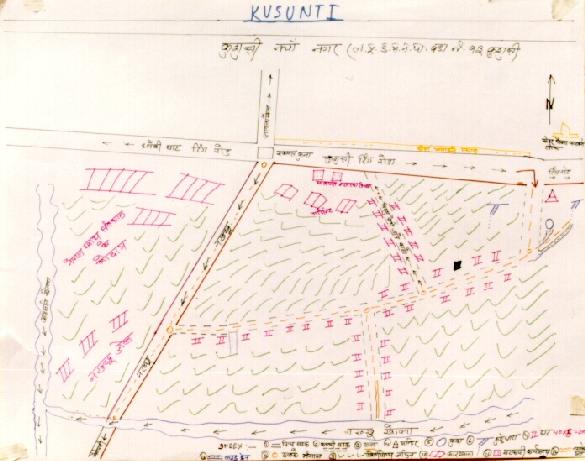

A report submitted by the participants from Kusunti
Kusunti diiffers considerably from the other communities. It is situated quite close to the ring road of Kathmandu. The last three years many houses have been built in the area, this development will continu. A couple of years ago a sewer line from Patan to the river has been constructed. At the time of our field visit the sewer line was not functioning, leading to a free flow of sewage trough the village. A far from hygenic situation.
Since Ward no. 13 Kusunti Nayanagar is a low land it has been polluted by wastewater. During (Nov. 2-13, 1998) the workshop organised by IRC, ENPHO and NEWAH, the participants, facilitators and organisers visited Kusunti Nayanagar. During field visit observations were made and interviews were taken, the findings of which are presented below.
In Kusunti Nayanagar the wastewater of ward no. 13, 4, and 5 and Rana era is released. Tap water of city water supply and sometimes even water from stone taps have been used for washing and bathing. Since most of the people in the area have migrated from other parts, they have contributed a lot in uplift of the society. Each family has 5-7 members . Each family uses about 50 liters of water. Since land is fertile 50% of the area is used for agriculture. 48% of the total land is residential and 2% public. Wastewater is released in own agricultural land. Once the sewer line has been installed the wastewater has been released in the sewer line and it is not good to reuse the wastewater. Main water sources are city supply, stone tap, dugwell, and springs.
People of this area are aware of consequences of higher costs of having big families. People are of the opinion that it would be good to release waste water in the river only after treatment. There is a lot of wastewater generated in this area due to carpet and dyeing factories. Probably the wastewater has 95% of organic pollutants. The wastewater can be managed only through the combined effort of donor agency and the local people. Every household has its own toilet and the toilet wastes are disposed in pits. Since these pits are temporary, leakage from these pits is common. Income source of the local people are service and house rent. Due to lack of cleanliness, most of the people suffer from diarrhoeal diseases. Since the residents have emigrated from other areas they do not have arable land and most are service holders.
People are of the opinion that after the construction of sewer line side drain is needed for irrigation. The most polluting agents which has caused environmental problems in this area are wastewater and pollutant of dyeing effluent. Local people have shown interest in managing wastes and have contributed voluntarily and also by providing certain funds. About 5000 people live in this area and the population growth is 2.3%. Some technical assistance can be met locally for the implementation of any project and also operation and management of small projects can be done locally. However, for big projects nothing can be said now. Rajkulo, the wastewater sewerline has been converted to flat road. Income of this community is low. The wastewater collected in this community is released in the stream and ponds nearby. Main festivals are Dasain, Tihar, Tij, Machhindra Nath procession etc. Main schools are Mahendra Bhrikuti Secondary School, Ajaya, Future Star etc. About 10,000 liters of wastewater in the rainy season and about 15,000 liters of wastewater in the dry season is generated by small scale industries. This community is motivated and interested in development activities.
In Kusunti sewer line is being laid in the process of managing wastewater. The wastewater will be released in the Nakhukhola since there is no alternative. However, people have shown concern about mixing effluent in the stream, Nakhukhola. Due to this concern shown and people's voice the construction of sewerline has been stopped for the time being. In order to overcome above mentioned problem, Kusunti community hereby requests to the donor agency to help them in accomplishing any of the following projects.
 |
|
Proposed surface drain, partially constructed and already damaged by monsoon rains |
|
|
|
Partially constructed sewer system |
Here flowed around 45.000 population equivalent sewage trough Kusunti. A rather negative exemple of introduced western technology |
|
|
Raw sewage flowing through the community |
Repair of the sewer |
|
|
| Another exemple of desinvestment | Partially still agricultural land |
|
|
The invading urbanisation |
A new appartment building |